The Audiences Page
The Audiences page is where you manage the audiences that have been built in your account.
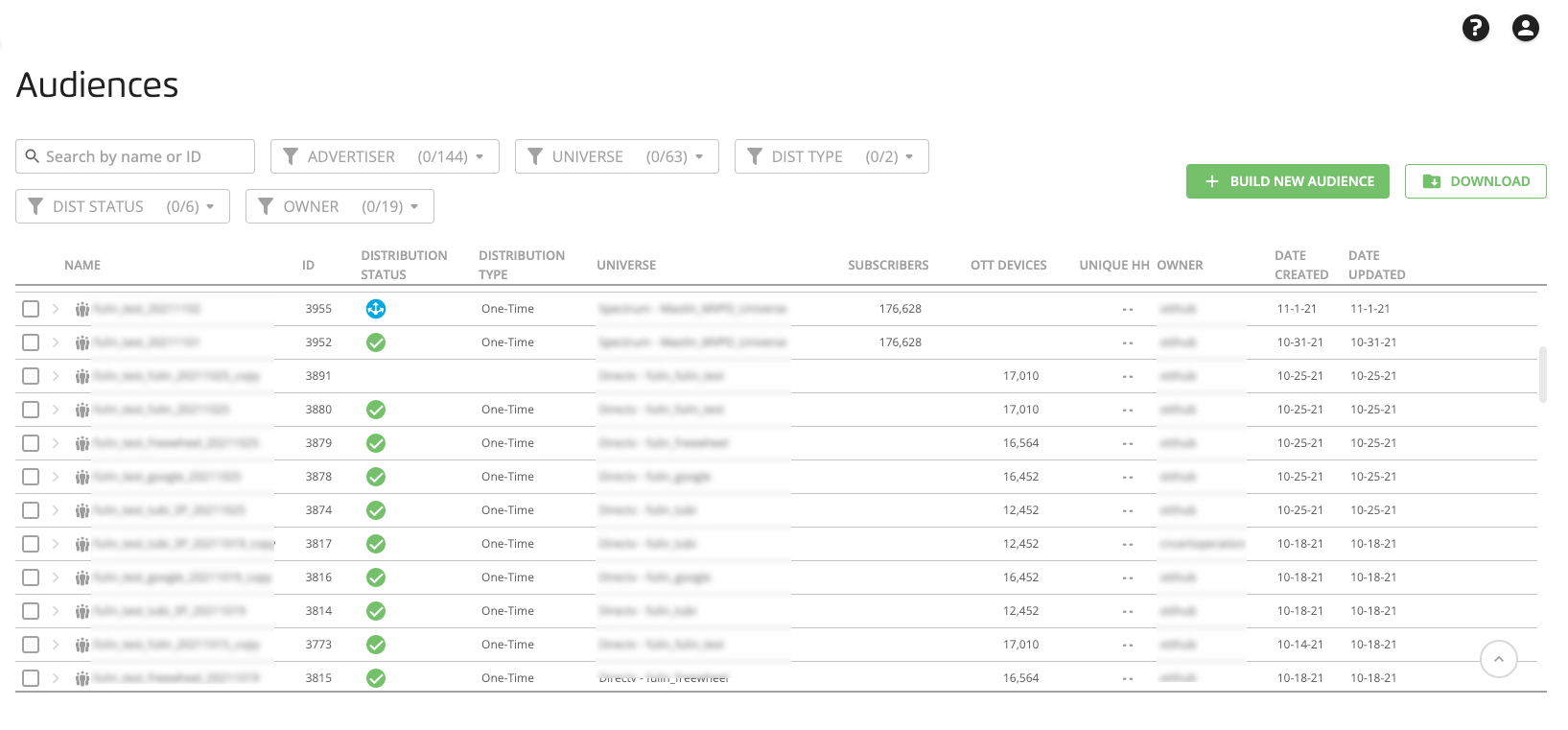
Note
To view information on any audiences that your partners (such as MVPD consortiums or other campaign planners) have built or are evaluating using your universes., go to the Activity Report page.
To access the Audiences page, click Audiences in the Campaigns section of the Advanced TV navigation menu,
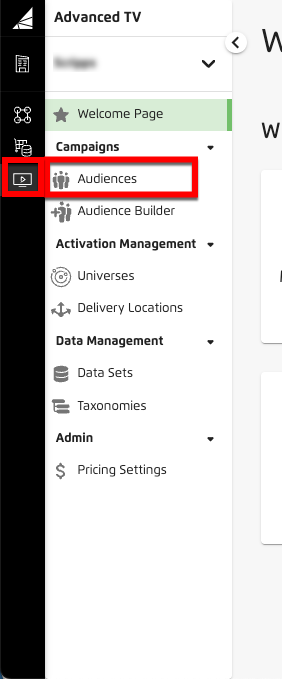
Tip
Alternatively, from the Welcome page, click the "Manage Audiences" tile.
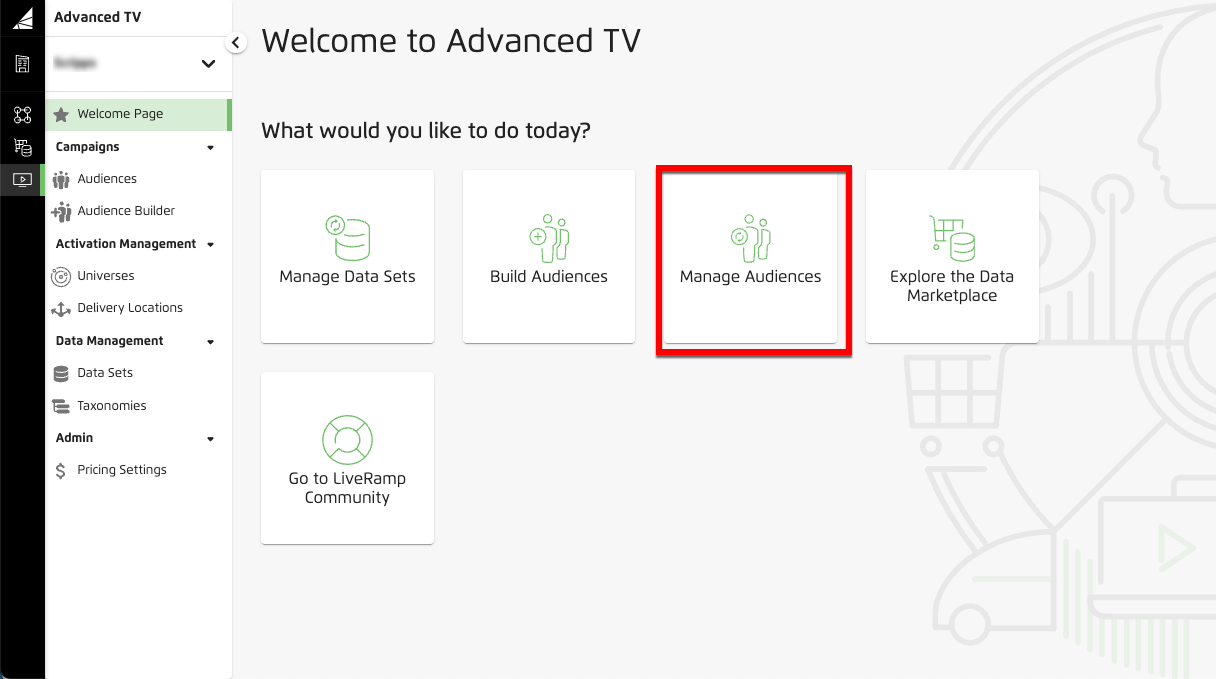
The audiences are listed in reverse chronological order (most recently updated audiences at the top of the list), with columns that provide additional information for each audience and the segments within each audience. You can click a row to open up the Audience Details panel for that audience.
Note
For an explanation of the metrics displayed, see "Advanced TV Terms and Concepts."
By default, the audiences are displayed collapsed. To view the segments that make up a particular audience, expand that audience by clicking the caret symbol to the left of the audience name for that audience.
Downloading an Audience Metadata Report
You can download an Excel file that contains collated metadata for your audiences or the segments in your audiences. The report includes all of the information contained in the Audiences page table, along with info on campaign dates and the types of data included (first-party data and/or third-party data).

Audience-level Report

Segment-level report
Tip
To download counts and criteria for individual audiences, see the instructions in "Download Audience Counts and Criteria."
To download an audience metadata report:
From the Advanced TV navigation menu, click Audiences in the Campaigns section to navigate to the Audiences page.

Tip
Alternatively, from the Welcome page, click the "Manage Audiences" tile.

If desired, filter the table with the search bar or any of the available filters.
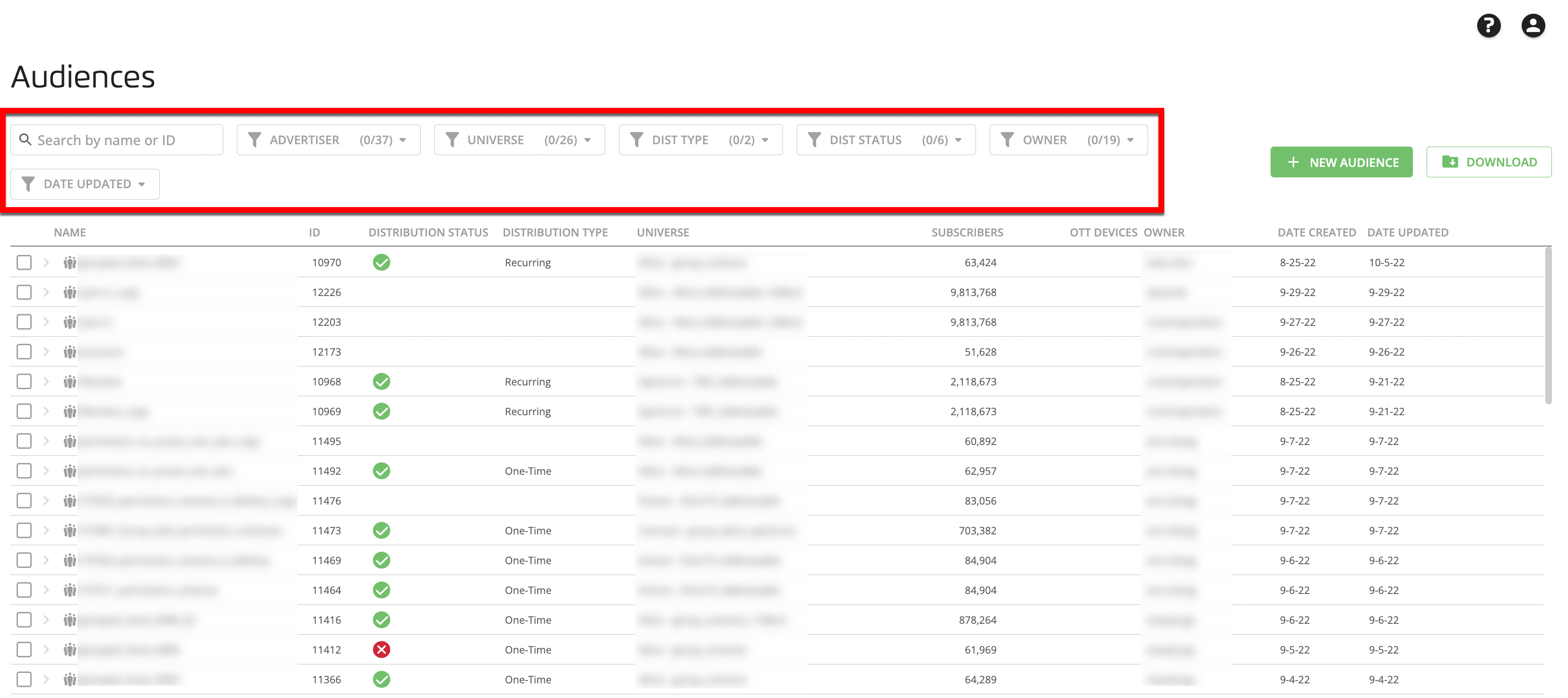
Note
The report will include all of the audiences or segments contained in the current view of the table. If no filters are applied, the report will include all of the audiences or segments in your account.
Click .
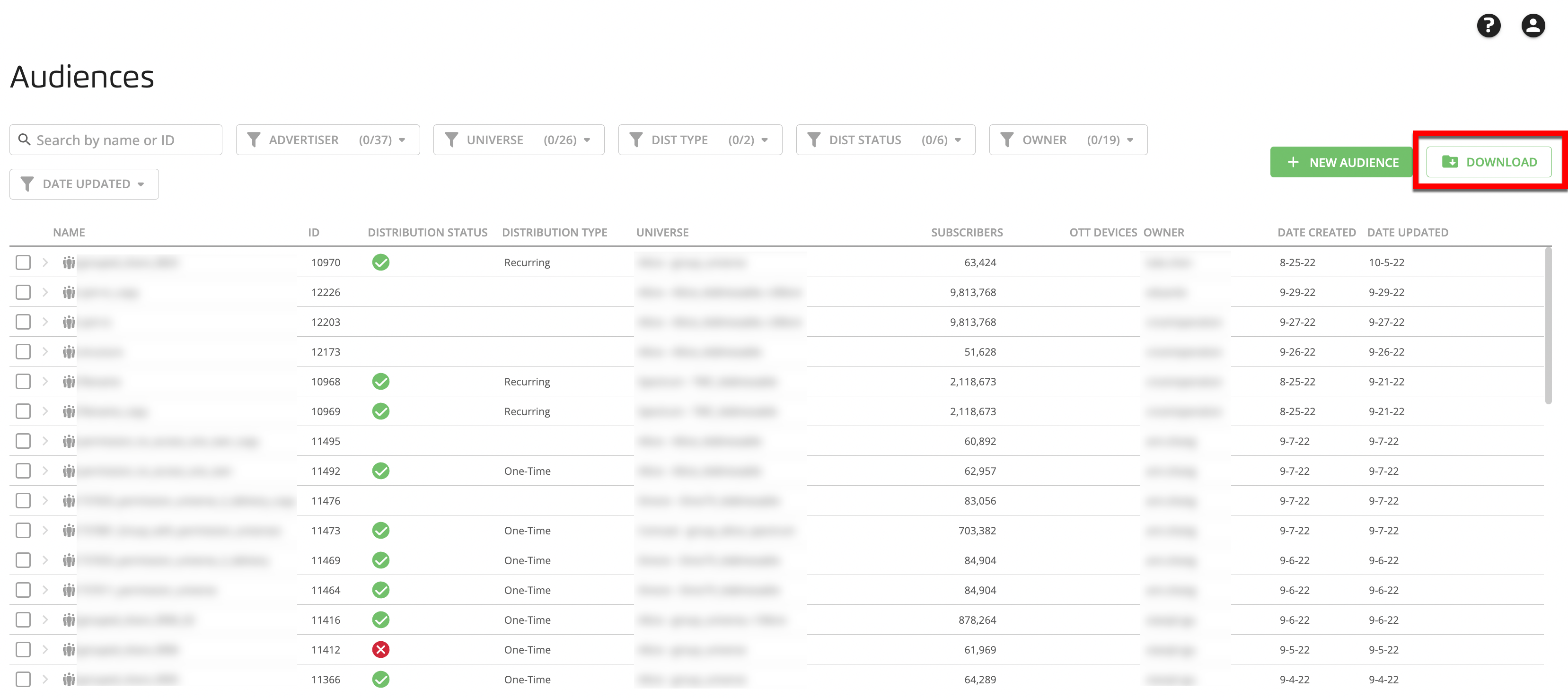
From the menu that displays, select one of the options:
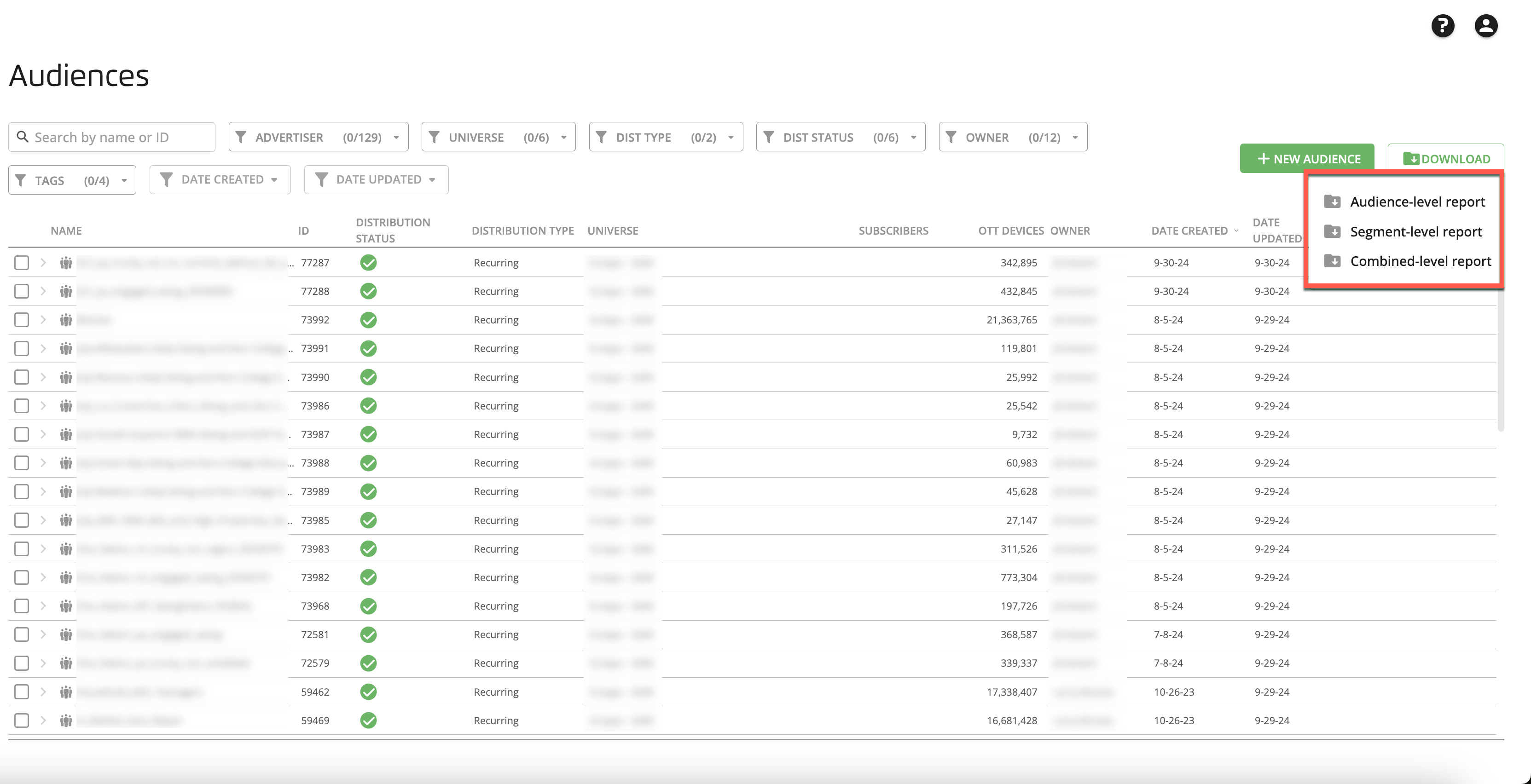
"Audience-level report" downloads a report listing information for each audience (with no segment-level information)
"Segment-level report" downloads a report with each segment in each audience broken out individually
"Combined-level report" downloads a report listing both audience and segment information.
The file downloads to your computer.
After the file downloads, you can open the file to view the report.
Audiences Page Column Headings
The Audiences page table contains the following columns:

Name: The name of the audience that was created when the audience was built. To see the segment name(s) for a particular audience, click the caret icon to the left of the audience name.
Note
All names are editable until a segment has been distributed.
ID: The ID of the audience or segment.
Note
Segment IDs can be modified by the audience owner but audience IDs are not editable.
Distribution Status: The distribution status for the audience:
Note
If the audience is distributing to more than one delivery location, or if the audience contains more than one universe, the status icon indicates the overall status of the audience distribution. Hover over the icon to view detailed distribution status information, broken down by universe and delivery location:

 Distribution Complete: The audience has been distributed to all of the platforms whose universes are included in the audience.
Distribution Complete: The audience has been distributed to all of the platforms whose universes are included in the audience. Distributing: The audience is being distributed to all of the platforms whose universes are included in the audience.
Distributing: The audience is being distributed to all of the platforms whose universes are included in the audience. Requested: The audience is pending your approval and is not yet being distributed.
Requested: The audience is pending your approval and is not yet being distributed. Requested: The audience is pending approval by the universe owner and is not yet being distributed.
Requested: The audience is pending approval by the universe owner and is not yet being distributed. Rejected: All of the MVPDs have rejected the distribution request and the audience is not distributing to any platform.
Rejected: All of the MVPDs have rejected the distribution request and the audience is not distributing to any platform. Multiple Status: Some platforms have approved distribution and some have not yet approved. The audience is being distributed to those platforms that have approved. Hover over the icon to see status information for each platform.
Multiple Status: Some platforms have approved distribution and some have not yet approved. The audience is being distributed to those platforms that have approved. Hover over the icon to see status information for each platform. Multiple Status: At least one MVPD has rejected distribution and others have either approved and/or not yet approved. The audience is being distributed to those MVPDs that have approved. Hover over the icon to see status information for each MVPD.
Multiple Status: At least one MVPD has rejected distribution and others have either approved and/or not yet approved. The audience is being distributed to those MVPDs that have approved. Hover over the icon to see status information for each MVPD. Processing: The audience is still being processed for distribution to the delivery location.
Processing: The audience is still being processed for distribution to the delivery location. Failed: There has been a transient failure. Contact your LiveRamp representative.
Failed: There has been a transient failure. Contact your LiveRamp representative.Campaign Completed: Activation has ended as the campaign date is in the past.
Distribution Type: Whether the distribution is a one-time distribution ("One-Time") or a recurring distribution ("Recurring"). See "Distribution Options" for more information.
Note
Distribution type info only appears after a distribution has been requested.
Note
For recurring distributions, if a red warning icon appears in the Distribution Type column (to the left of the "Recurring" distribution type), the audience no longer meets one or more thresholds after a refresh of the counts and will not continue to distribute to the affected universe(s).
For one-time distributions, if a yellow warning icon appears in the Distribution Type column (to the left of the "One-Time" distribution type), the audience no longer meets one or more thresholds after a refresh of the counts and cannot be distributed to the affected universe(s) by editing the distribution type.
You can either duplicate the audience and adjust it so that it meets the thresholds, or you can contact the universe owners to see if they can increase the thresholds.
Universe: The universe(s) this audience was built on. Hover over the entry to display the universe names if there isn’t sufficient room to display them in the column.
Subscribers: The total number of subscribers contained in the audience.
Note
Hover over the number to see a breakdown of the types of subscribers the audience contains (MVPD subscribers and/or OTT subscribers) and numbers for each type
Note
Counts are also broken down by each segment within an audience.
OTT Devices: The number of OTT devices contained in the audience.
Note
Hover over the number to see a breakdown of the categories of OTT devices the audience contains (OTT devices, OTT converted HH, and/or unassociated OTT devices) and numbers for each type
If the audience has been distributed, the count is based off the subscriber or viewer file from when the audience was distributed.
If the audience has not been distributed, then the count is based off the most recent subscriber or viewer file.
Unique HH: For customers who have opted in, the number of unique households contained in the audience. This count is only displayed for audiences that were built on universes where computing household counts has been enabled. If the audience has been saved within the last 15 minutes, “processing” might be displayed to indicate that the count is currently being generated. Note: For audiences where computing household counts has not been enabled, two dashes are displayed.
Owner: The user that built the audience.
Note
Only the user that owns an audience can edit or delete that audience.
Date Created: The date the audience was created.
Date Updated: The date the audience was last edited or was distributed. See the section below for more information.
Actions That Cause the Audience Update Time To Change
The update time changes when any one of the following actions occur:
The audience name is changed.
Any audience criteria is changed, including changes to the universes used, the data used, the segment IDs. Capping the audience or a segment, or enabling test and control groups, will also result in a change to the update time.
The audience is distributed.
Searching and Filtering the Audiences Table
You can use the search box and the filters to refine the list of audiences that appears in the Audiences table.
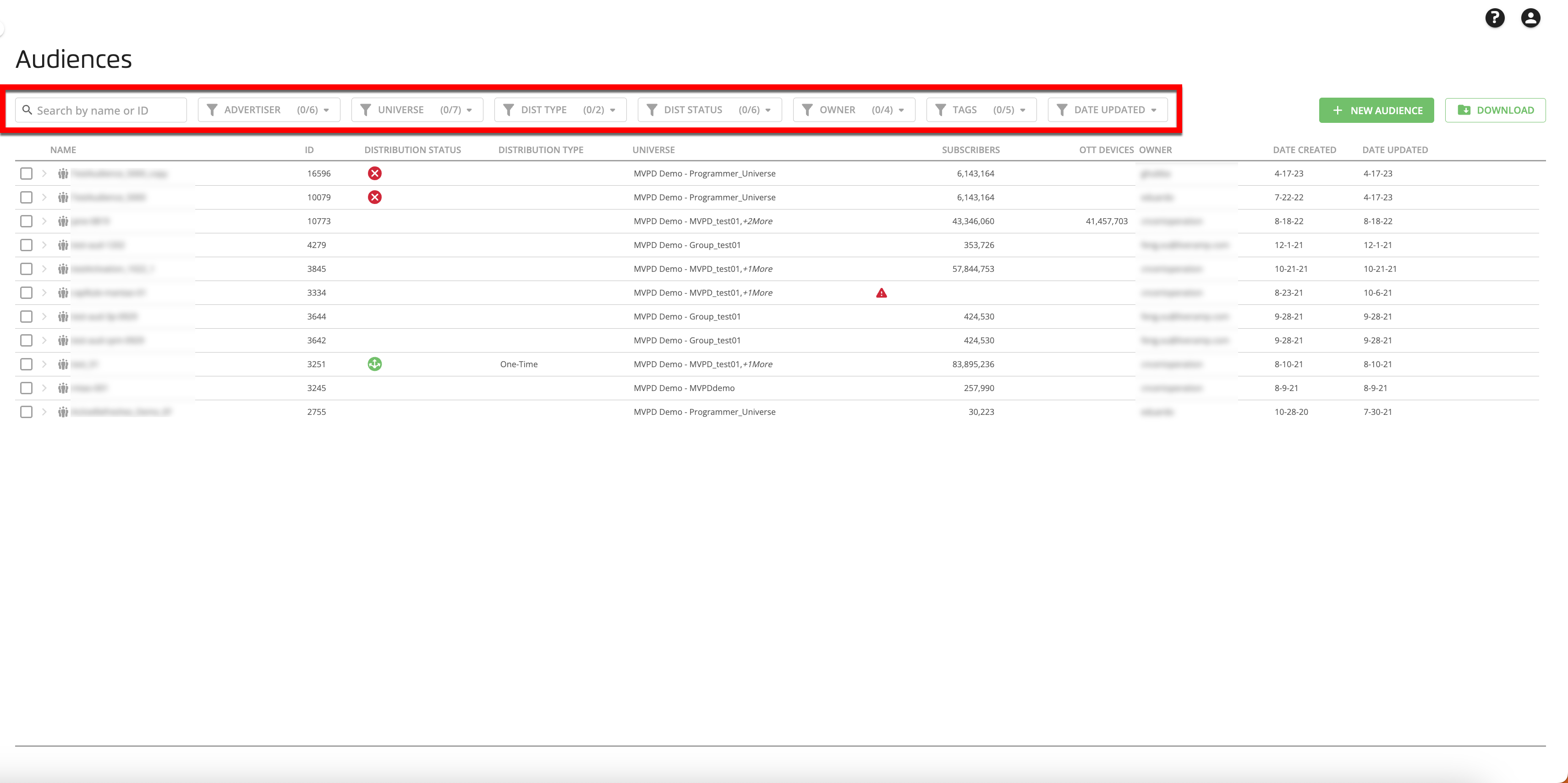
Search: You can search using the following criteria:
Audience Name
Segment Name
Audience ID
Segment ID
Filter: You filter on the following categories:
Advertiser
Universe
Delivery Location
Distribution Type (one-time, recurring)
Distribution Status (not started, distributing, requested, rejected, complete, failed)
Owner (the user that created the audience)
Tags (for more information on tags, see "Use Audience Tags")
Date
Note
For filters that contain a large number of entries, you can use the search box within that filter to make it easier to find your desired entry.
Audience Warning Icons
For audiences that you’ve built using a universe that a partner has permissioned to you, you might see yellow or red triangular warning icons in those rows. If one of these appears, that indicates that the partner has revoked the permission to that universe or has changed the filter attributes for that permissioned universe in a way that affects the audience that you’ve built.
A red triangular warning icon
 in the Universe column indicates that the audience has been built entirely from one or more permissioned universes where those permissions have all been revoked. The audience cannot be distributed until those universes are removed and the audience is built using only universes with active permissions.
in the Universe column indicates that the audience has been built entirely from one or more permissioned universes where those permissions have all been revoked. The audience cannot be distributed until those universes are removed and the audience is built using only universes with active permissions.A yellow triangular warning icon
 in the Universe column indicates that the audience has been built using multiple universes but that the permission has been revoked for some subset of the universes used. Hover over the icon to see which universes have been revoked. The audience cannot be distributed until those universes are removed and the audience is built using only universes with active permissions.
in the Universe column indicates that the audience has been built using multiple universes but that the permission has been revoked for some subset of the universes used. Hover over the icon to see which universes have been revoked. The audience cannot be distributed until those universes are removed and the audience is built using only universes with active permissions.A red triangular warning icon
 in the Distribution Type column indicates that an audience that is distributing using the "recurring" distribution option no longer meets one or more thresholds after a refresh. To continue distributing the audience, you can either duplicate the audience and adjust it so that it meets the thresholds, or you can contact the universe owners to see if they can increase the thresholds.
in the Distribution Type column indicates that an audience that is distributing using the "recurring" distribution option no longer meets one or more thresholds after a refresh. To continue distributing the audience, you can either duplicate the audience and adjust it so that it meets the thresholds, or you can contact the universe owners to see if they can increase the thresholds.A yellow triangular warning icon
 in the Distribution Type column indicates that an audience that has previously been distributed using a "one-time" distribution option no longer meets one or more thresholds after a refresh. If you want to redistribute the audience, you can either duplicate the audience and adjust it so that it meets the thresholds, or you can contact the universe owners to see if they can increase the thresholds.
in the Distribution Type column indicates that an audience that has previously been distributed using a "one-time" distribution option no longer meets one or more thresholds after a refresh. If you want to redistribute the audience, you can either duplicate the audience and adjust it so that it meets the thresholds, or you can contact the universe owners to see if they can increase the thresholds.A yellow triangular warning icon
 to the left of the Subscriber column indicates that the audience has been built using one or more filter attributes that have been revoked. The audience cannot be distributed until those filter attributes are removed and the audience is built using only permissioned filter attributes. Click the icon to see a list of revoked filter attributes, and to have the option to remove those filter attributes (by clicking Dismiss Attributes) or to edit the audience (by clicking Edit Audience).
to the left of the Subscriber column indicates that the audience has been built using one or more filter attributes that have been revoked. The audience cannot be distributed until those filter attributes are removed and the audience is built using only permissioned filter attributes. Click the icon to see a list of revoked filter attributes, and to have the option to remove those filter attributes (by clicking Dismiss Attributes) or to edit the audience (by clicking Edit Audience).A red triangular warning icon
 to the left of the Subscriber column indicates that the audience does not meet one or more thresholds. The audience cannot be distributed until all thresholds are met. Edit the audience to fix the issue.
to the left of the Subscriber column indicates that the audience does not meet one or more thresholds. The audience cannot be distributed until all thresholds are met. Edit the audience to fix the issue.
See “Edit an Audience” for instructions on how to edit the audience to remove any revoked universes or filter attributes, or to meet audience thresholds.
Actions You Can Perform on Audiences
If you check the check box next to a particular audience, icons appear at the bottom of the page for you to perform actions on that audience. The actions available depend on several conditions:
Whether you own the audience

Whether the audience has been distributed

Whether the distribution type for the audience is "Recurring"

The actions listed below can be performed on audiences (some icons might be grayed out, and the available actions might vary, depending on the status of the audience or whether someone other than you owns that audience).
Edit an existing audience by clicking the edit audience icon (
 ) (if you own that audience and the audience hasn't been distributed)
) (if you own that audience and the audience hasn't been distributed)Edit the distribution by clicking the edit distribution icon (
 ) (if the audience has been distributed)
) (if the audience has been distributed)Duplicate an audience by clicking the duplicate icon (
 ) (so you can edit an audience that you do not own or that has already been distributed)
) (so you can edit an audience that you do not own or that has already been distributed)Download a file by clicking the download icon (
 ) that contains information on the audience and how it was constructed
) that contains information on the audience and how it was constructedDelete an audience by clicking the delete icon (
 ) (if you own that audience and the audience hasn't been distributed)
) (if you own that audience and the audience hasn't been distributed)Distribute an audience by clicking the distribute icon (
 ) (if the audience has not been distributed)
) (if the audience has not been distributed)Refresh the distribution by clicking the refresh distribution icon (
 ) (if the audience is being distributed and the distribution type is "Recurring")
) (if the audience is being distributed and the distribution type is "Recurring")Add or remove tags by clicking the tag icon (
 )
)
Note
To refresh the unique household counts for a particular audience, edit the audience and then save it without making any changes.
In addition, you can start the process of building a new audience from this page by clicking + New Audience.
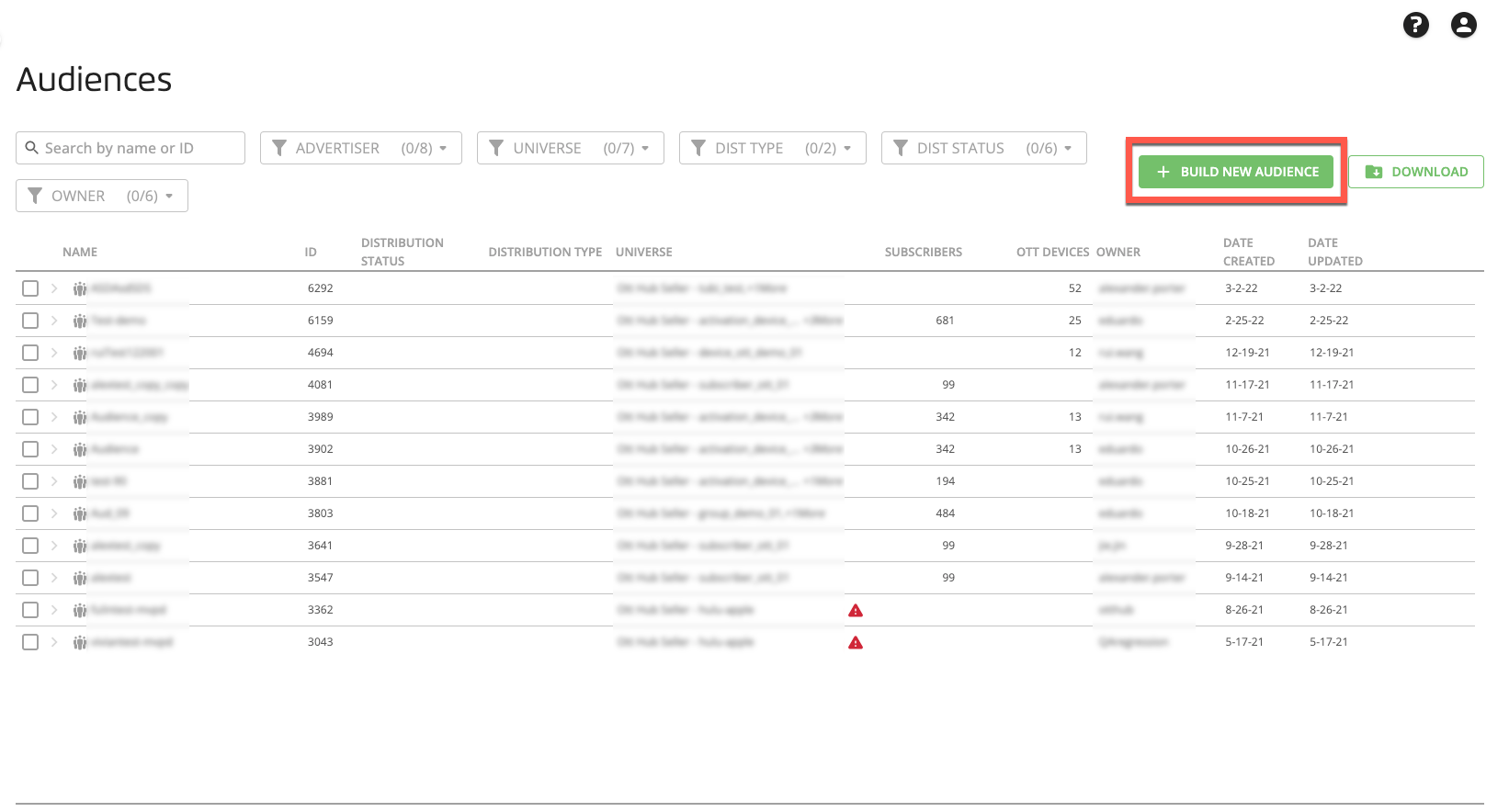
The Audience Details Panel
To open the Audience Details panel, click the row for the audience you want to view details for.
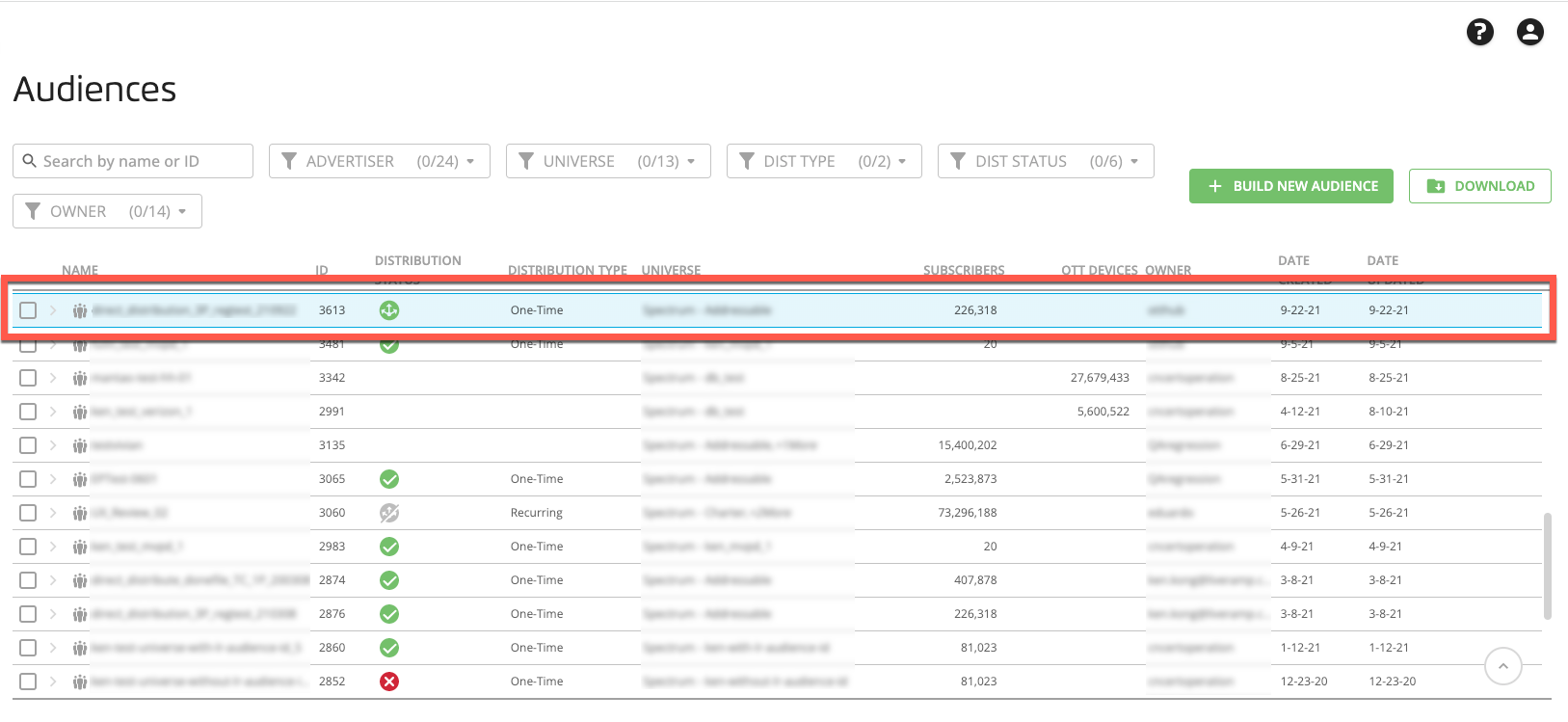
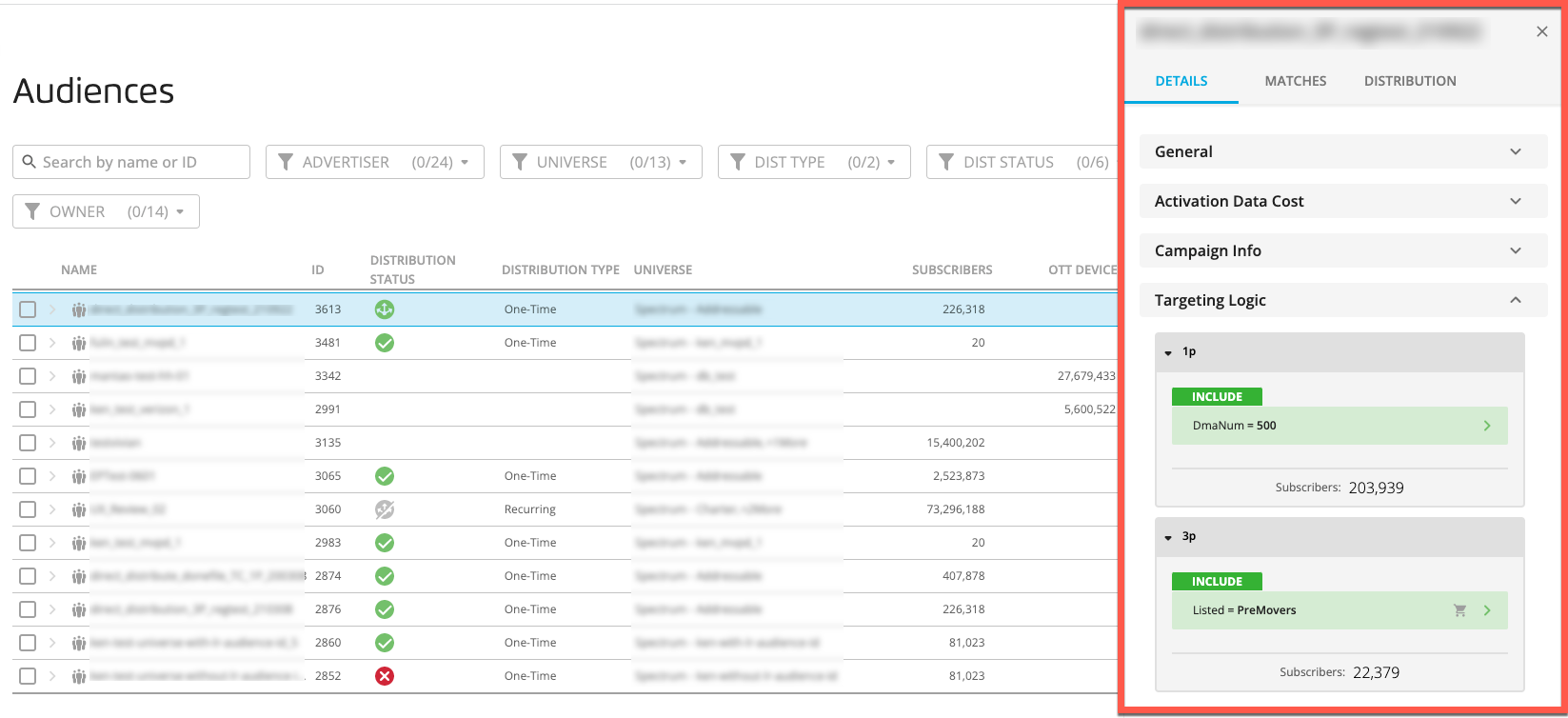
The panel contains the following areas:
The DETAILS tab area displays the general info, the activation data cost (CPM), campaign info, advanced audience settings, and targeting logic.
The MATCHES tab area displays aggregate matches and a matches breakdown by universe and segment.
The DISTRIBUTION tab area displays the distribution status for each universe's delivery locations for every distribution.
Note
See the sections below for information on each tab area.
When you’re done viewing the details, click the X in the upper right of the panel to close the panel.
The DETAILS tab of the Audience Details panel contains the information listed below.
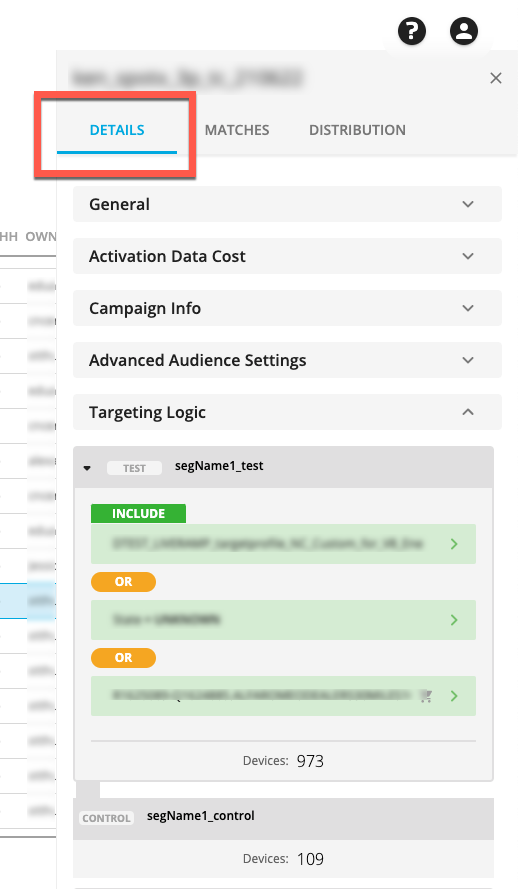
Note
When viewing the Audience Details panel from the Activity Report page, no Activation Data Cost section appears.
Note
Some sections are displayed collapsed when the panel first opens. Click the caret to the right of the section name to expand (or collapse) a particular section.
The General Section
The General section contains the following information:
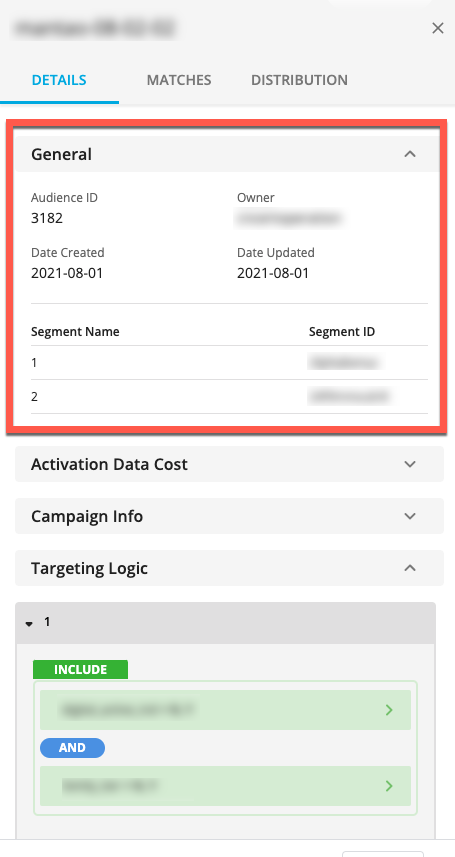
Audience ID
Audience owner (the user who created the audience)
Date created
Date updated
The segment names and IDs (if any) for all segments in the audience
The Activation Data Cost Section
The Activation Data Cost section contains info on the CPM for the overall audience and for each segment in that audience:
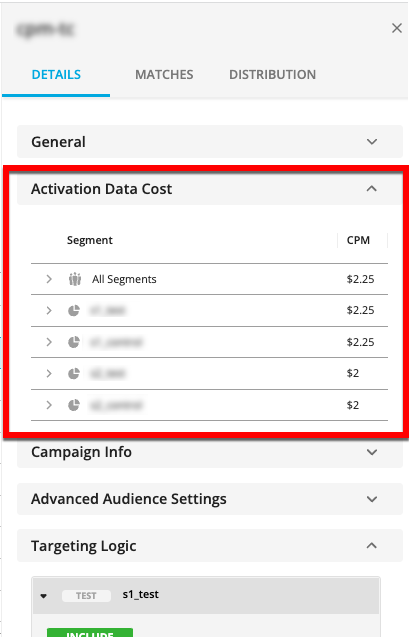
Note
When viewing the Audience Details panel from the Activity Report page, no Activation Data Cost section appears.
To see a breakdown of the costs for the overall audience or one of the segments in the audience, click the caret to the left of the audience or segment name:

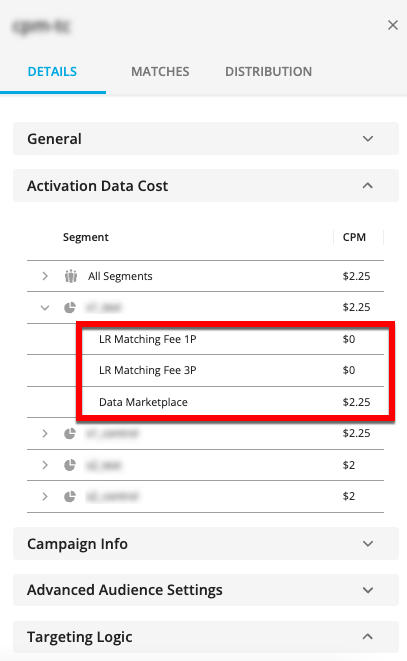
The Campaign Info Section
The Campaign Info section contains the following information:
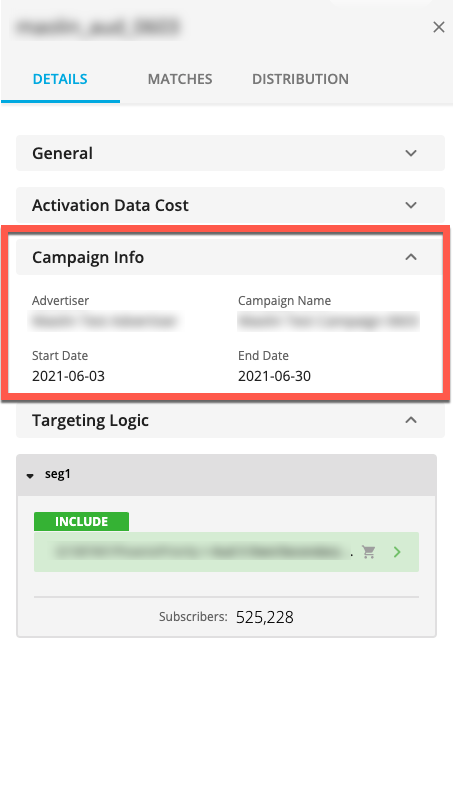
Advertiser name
Campaign name
Campaign start date
Campaign end date
If the audience was shared to an external platform partner via API, an additional field displays:
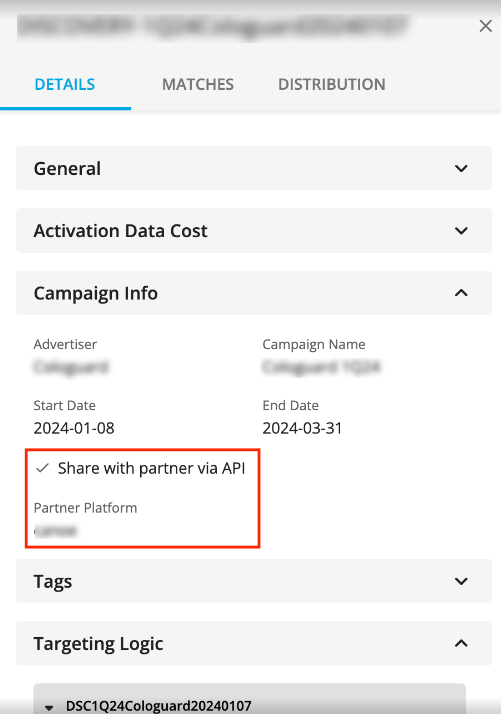
The Advanced Audience Settings Section
If advanced audience settings have been enabled for the audience, the Advanced Audience Settings section appears and displays information on those settings:
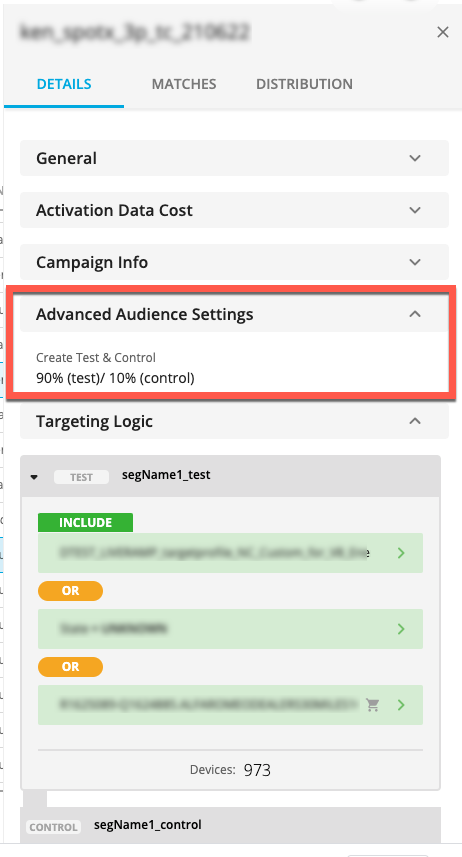
Note
If no advanced audience settings have been enabled, this section does not appear.
If the Cap Audience feature has been enabled, you can click the caret to view additional audience cap criteria.
If the Remove Duplicates feature has been enabled, the priority criteria are displayed, and you can click the caret to view the priority order.
If test and control has been enabled, you can view the test and control percentages.
The Targeting Logic Section
The Targeting Logic section displays segment names, Boolean logic operators, and subscriber and device counts for each segment in the audience.
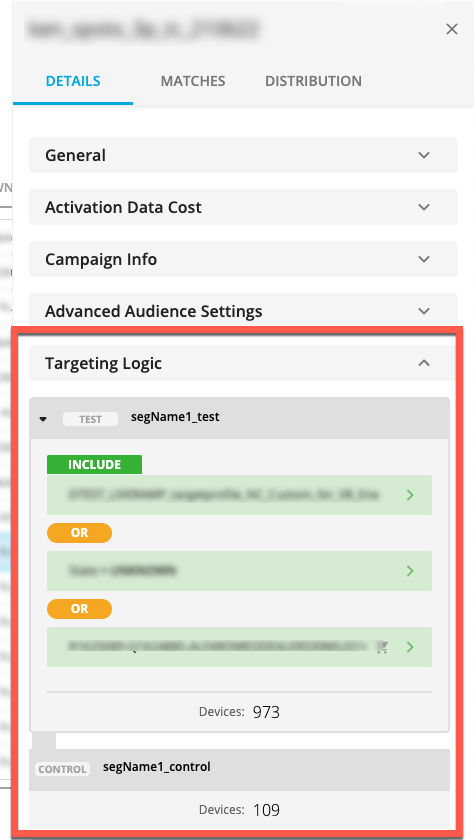
Note
You might have to scroll down to view all of the segments in the audience.
To view the included attributes for an individual segment component, click the caret on the right side of the row for that segment component.
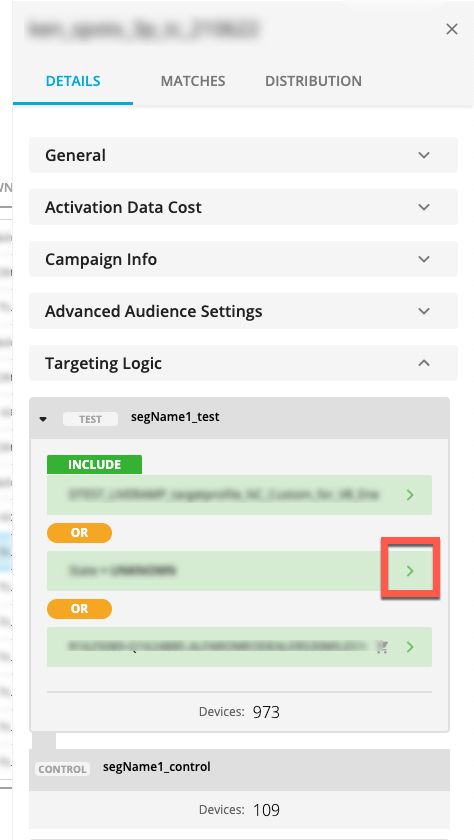
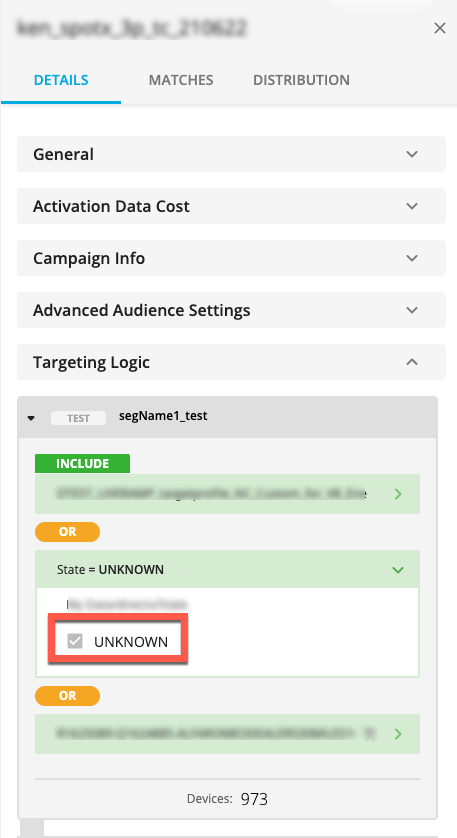
Note
If duplicates have been removed, a "deduplicated match" icon ( ) appears next to each displayed value that is affected. When you hover over the icon, a tooltip displays the non-deduplicated number.
) appears next to each displayed value that is affected. When you hover over the icon, a tooltip displays the non-deduplicated number.

If caps have been set and are affecting a count, a "capped match" icon ( ) appears next to each displayed value that is affected. When you hover over the icon, a tooltip displays the non-capped number.
) appears next to each displayed value that is affected. When you hover over the icon, a tooltip displays the non-capped number.
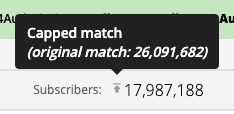
If a value is affected by both deduplication and capping, both icons appear next to each displayed value that is affected. When you hover over the icons, a tooltip displays the non-capped and non-deduplicated number.
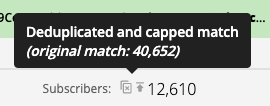
The MATCHES tab of the Audience Details panel contains subscriber and/or device matches for the audience. If the audience has been enabled for unique household counts, the unique households number is also displayed.
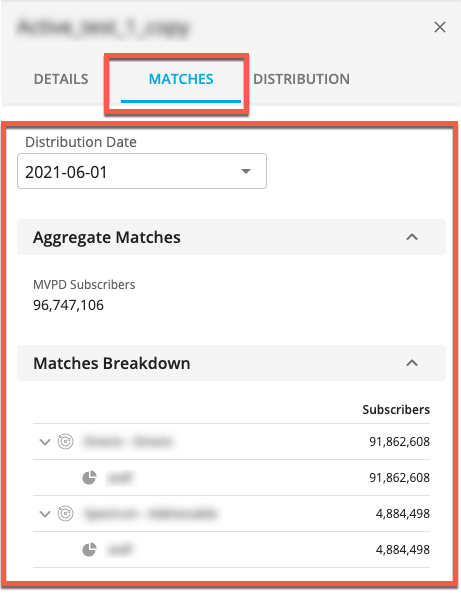
If the audience has been successfully distributed, the counts reflect the matches at the time of distribution (indicated by the Distribution Date). If the audience has not been successfully distributed, the counts reflect the matches at the time of audience creation.
For audiences with multiple successful distributions, you can use the Distribution Date dropdown to see the matches for a past distribution date.
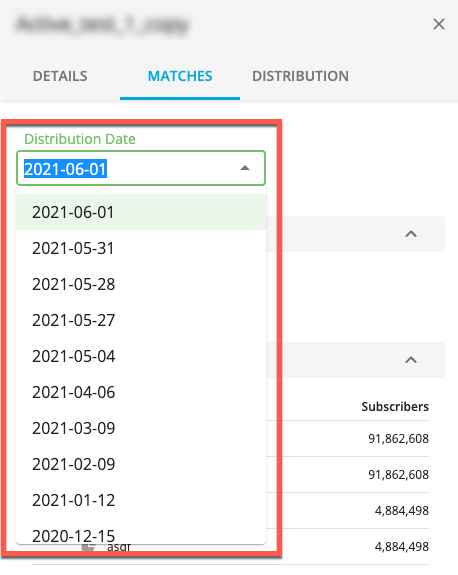
Note
If duplicates have been removed, a "deduplicated match" icon ( ) appears next to each displayed value that is affected. When you hover over the icon, a tooltip displays the non-deduplicated number.
) appears next to each displayed value that is affected. When you hover over the icon, a tooltip displays the non-deduplicated number.

If caps have been set and are affecting a count, a "capped match" icon ( ) appears next to each displayed value that is affected. When you hover over the icon, a tooltip displays the non-capped number.
) appears next to each displayed value that is affected. When you hover over the icon, a tooltip displays the non-capped number.

If a value is affected by both deduplication and capping, both icons appear next to each displayed value that is affected. When you hover over the icons, a tooltip displays the non-capped and non-deduplicated number.

The Aggregate Matches Section
The Aggregate Matches section shows the total number of matches. This might include subscriber matches, OTT device matches, and/or unique household matches, depending on the makeup and configuration of the audience.
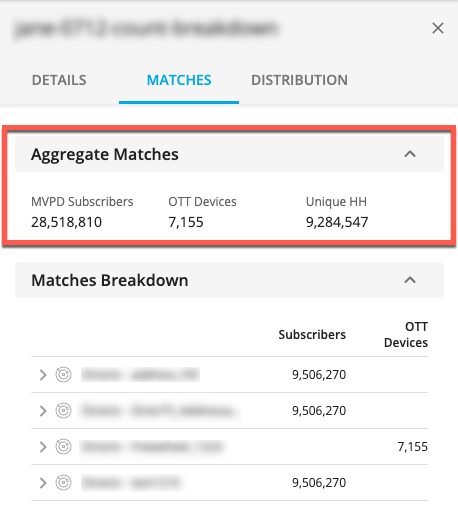
The Matches Breakdown Section
The Matches Breakdown section shows matches broken down by universe or by segment, depending on how the audience was configured:
Note
Universes are indicated by a universe icon ( ) and segments are indicated by a segment icon (
) and segments are indicated by a segment icon ( ).
).
For audiences that have been configured by universe, the segment matches are displayed under each universe.

Note
For any grouped universes you own that are included, you can also see a breakdown by each component universe.
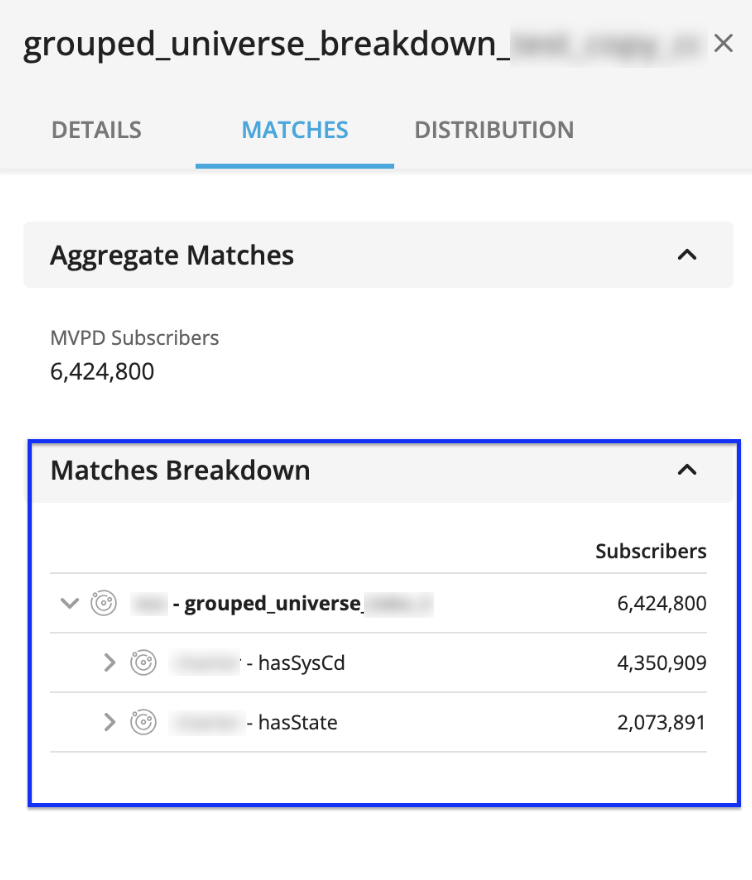
For audiences that have been configured by segment, the universe matches are displayed under each segment.
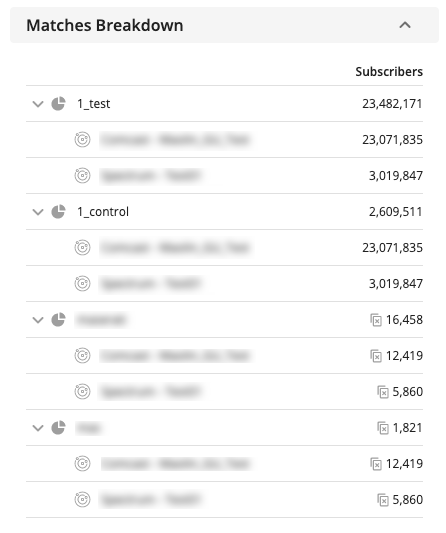
The DISTRIBUTION tab of the Audience Details panel contains information on any audience distributions.
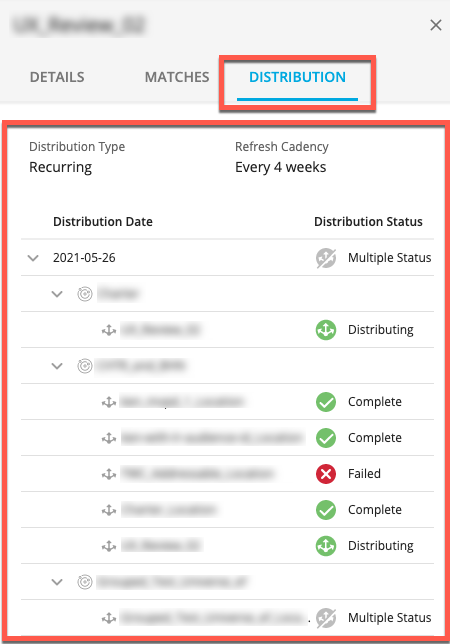
For audiences that have been distributed, distribution info is displayed, including distribution type (one-time or recurring), the distribution dates, the refresh cadence, and the date of the next scheduled distribution (for recurring distributions). See "Distribution Options" for more information.
Overall Distribution Statuses
The overall distribution status is displayed for each distribution:
 Distribution Complete: The audience has been distributed to all delivery locations.
Distribution Complete: The audience has been distributed to all delivery locations. Distributing: The audience is being distributed to all delivery locations.
Distributing: The audience is being distributed to all delivery locations. Processing: The audience is still being processed for distribution to all delivery locations.
Processing: The audience is still being processed for distribution to all delivery locations. Failed: There has been a transient failure. Contact your LiveRamp representative.
Failed: There has been a transient failure. Contact your LiveRamp representative. Multiple Status: There are different statuses for the delivery locations for this distribution but no delivery locations have a status of "Rejected" or Failed". Click the carets to expand the distribution and view the status for each delivery location.
Multiple Status: There are different statuses for the delivery locations for this distribution but no delivery locations have a status of "Rejected" or Failed". Click the carets to expand the distribution and view the status for each delivery location. Multiple Status (Failed/Rejected): There are different statuses for the delivery locations for this distribution including at least one delivery location with a status of "Rejected" or Failed". Click the carets to expand the distribution and view the status for each delivery location.
Multiple Status (Failed/Rejected): There are different statuses for the delivery locations for this distribution including at least one delivery location with a status of "Rejected" or Failed". Click the carets to expand the distribution and view the status for each delivery location. Scheduled: The audience is scheduled to be distributed on the date shown.
Scheduled: The audience is scheduled to be distributed on the date shown.
Delivery Location Distribution Statuses
To see the distribution status for a universe's delivery locations, click the caret to the left of the distribution date and then click the caret to the left of the desired universe:
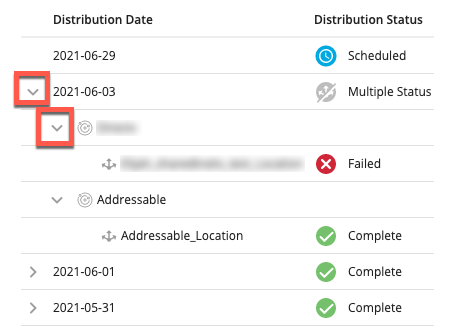
Note
Universes are indicated by a universe icon ( ) and delivery locations are indicated by a delivery location icon (
) and delivery locations are indicated by a delivery location icon ( ).
).
The following delivery location distribution statuses might appear:
 Distribution Complete: The audience has been distributed to this delivery location.
Distribution Complete: The audience has been distributed to this delivery location. Distributing: The audience is being distributed to this delivery location.
Distributing: The audience is being distributed to this delivery location. Processing: The audience is still being processed for distribution to this delivery location.
Processing: The audience is still being processed for distribution to this delivery location. Requested: The distribution to this delivery location is pending your approval and the audience is not yet being distributed to this delivery location.
Requested: The distribution to this delivery location is pending your approval and the audience is not yet being distributed to this delivery location. Requested: The distribution to this delivery location is pending approval by the universe owner and the audience is not yet being distributed to that delivery location.
Requested: The distribution to this delivery location is pending approval by the universe owner and the audience is not yet being distributed to that delivery location. Rejected: The universe owner has rejected the distribution request to this delivery locations and the audience is not distributing to the delivery location.
Rejected: The universe owner has rejected the distribution request to this delivery locations and the audience is not distributing to the delivery location. Failed: There has been a transient failure. Contact your LiveRamp representative.
Failed: There has been a transient failure. Contact your LiveRamp representative.
Viewing File Name(s) for Completed Distributions
You can view the file name(s) for your completed audience distributions.
Note
You will also receive an email notification that contains that information.
File names are only available for deliveries that have been completed.
From the distribution dates that appear, find the desired date and expand the selection by clicking the carets until you reach the desired delivery location (a file icon should appear next to the delivery location).
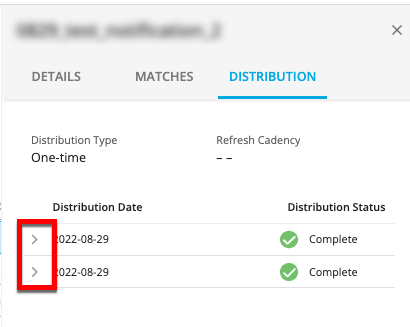
Note
File names are only available for deliveries that have been completed.
Click the file icon.
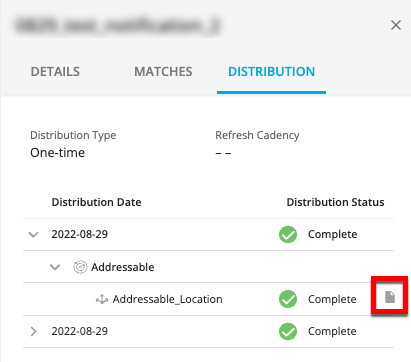
From the dialog that opens, one or more file names appear that you can view or copy (in certain circumstances, multiple files are created for a single distribution).
